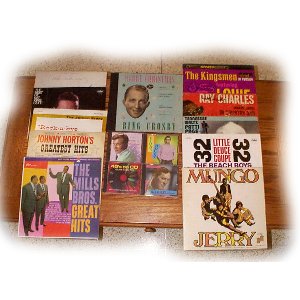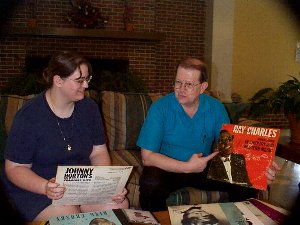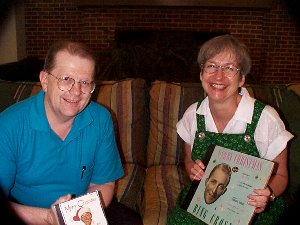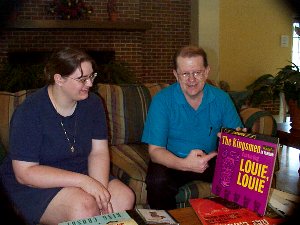Have you ever heard
|
 |
Have you ever heard
|
 |
Have you ever heard of The Ink Spots or The Mills Brothers? Well, Dr. George Washburn, affectionately known at Judson as "ComputerMan George," has heard of these groups and many more. These are just two of the many groups he has encountered in his 40 year love affair with Golden Oldies. When asked how he became interested in the music of this era gone by, he speaks of his youth when his parents would work late and leave the radio on for George and his sister to listen to at night. After that, he was hooked.
 George
began building his repertoire of musical knowledge in grade school when he
listened to radio more that anything else. His favorite was WBAM’s
program called Dan’s Dusty Disks. The great thing about this
particular program was that it told the listeners the names of the songs
and who did them. Once George heard the tune it stuck with him. Later when
the first station dedicated entirely to Oldies, KLOK in San
Jose,California, was put on the air, he tuned in and expanded his already
impressive knowledge of the genre.
George
began building his repertoire of musical knowledge in grade school when he
listened to radio more that anything else. His favorite was WBAM’s
program called Dan’s Dusty Disks. The great thing about this
particular program was that it told the listeners the names of the songs
and who did them. Once George heard the tune it stuck with him. Later when
the first station dedicated entirely to Oldies, KLOK in San
Jose,California, was put on the air, he tuned in and expanded his already
impressive knowledge of the genre.
Now the ComputerMan is an avid collector of the Golden Oldies. "The CD is the biggest boon to Oldies," says George, "because now people can buy music that has not been available to the public for sometimes 50 to 70 years." He still collects records though. In fact, he once paid ten dollars for a Mungo Jerry album just to get one song. Mungo Jerry? Only true aficionados of Golden Oldies remember.
Between his collection of albums and seeking out songs on CD, George Washburn has built quite a collection of Oldies. This assortment includes an original copy of Bing Crosby’s White Christmas, the number one selling song of all time. ComputerMan George reports that it was recorded so many times that the steel master disc they used had to be replaced because the grooves had worn down. Also within the collection we find the work of the Mills Brothers, Nat King Cole, and Johnny Horton.

George tells about a 70’s song called The Day the Music Died . It was written about the unexpected deaths of Buddy Holly, The Big Bopper, and Richie Valenz, who all died together in a plane crash. Three of the best entertainers of the time were killed in one tragic blow. Shortly thereafter, a rash of other losses left the music world hurting.
Odd coincidences marked these deaths because of the eerie correlation between some singers deaths and their last songs. Patsy Cline recorded I Fall to Pieces, and a short time later was killed in a plane crash. Chuck Willis died just after releasing the song I’m Going to Hang up my Rock and Roll Shoes.
Death was a major part of the musical subject matter then, George observes. Several songs, such as Teen Angel and Tell Laura, were recorded proclaiming that devotion to one’s sweetheart was greater than fear of death and showing the listener how far a person could go for love. Commitment was a strong theme in that society, and music reflected the ideals of the day. (This is why it's such a pleasure to listen to today.) Music is the mouthpiece of society and songs like Down in the Boondocks helped convey the American ideal of a classless society. This beat lives on today in CD’s and records.
 Did
you know that Billy Joe Royal, Billy J. Kramer, and B J Thomas all had
hits the same summer? That one radio station had a Louie, Louie
fest and played that one song all weekend long? No? Well neither did I,
but ComputerMan George does. So the next time you have a question about
the early days of rock and roll or the golden age of radio, ask Dr.
Washburn and discover a whole new world of things you never knew you never
knew.
Did
you know that Billy Joe Royal, Billy J. Kramer, and B J Thomas all had
hits the same summer? That one radio station had a Louie, Louie
fest and played that one song all weekend long? No? Well neither did I,
but ComputerMan George does. So the next time you have a question about
the early days of rock and roll or the golden age of radio, ask Dr.
Washburn and discover a whole new world of things you never knew you never
knew.